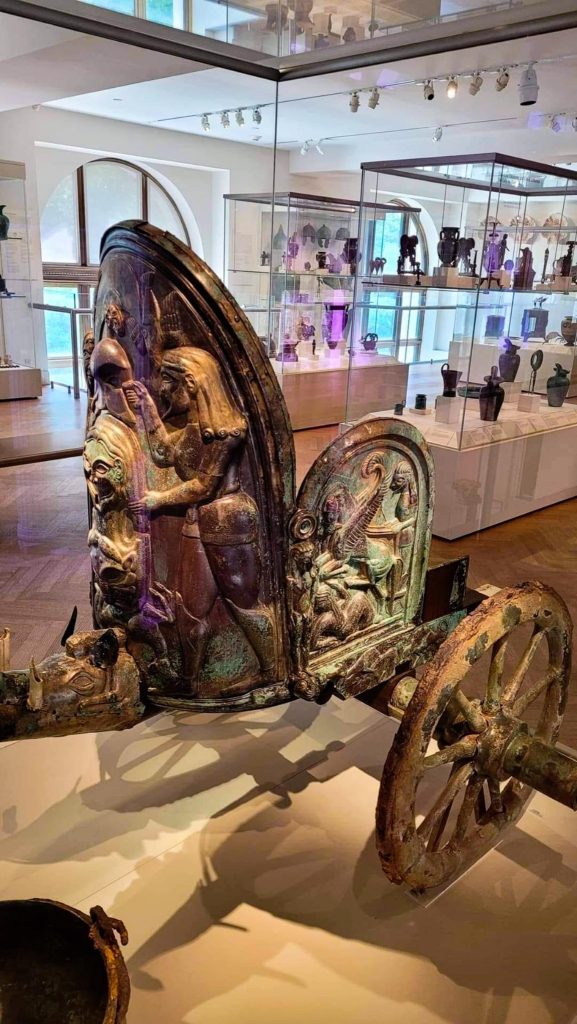In 1902, a shepherd named Isidoro Vannozzi made an astonishing discovery while constructing a farmhouse in the village of Monteleone di Spoleto, located near Spoleto in the region of Umbria, Italy. Hidden beneath the soil, within the confines of an ancient tomb, lay a magnificent artifact from the distant past—the Monteleone Chariot. This remarkable ceremonial vehicle, dating back to the 6th century BCE, was not an ordinary mode of transport, but a beautifully crafted Etruscan chariot, rich with artistic and historical significance. Alongside it were numerous bronze, ceramic, and iron utensils, as well as grave goods that offered an extraordinary glimpse into the life and rituals of the Etruscan civilization.

Following its discovery, the Monteleone Chariot began an unexpected journey that would take it far from its original home. After recovering the chariot from the tomb, Vannozzi sold it to Benedetto Petrangeli, a local scrap metal dealer. Despite its clear artistic and archaeological value, the chariot was treated as a commodity. In fact, it remained hidden in Vannozzi’s barn for some time until he eventually exchanged it with two Frenchmen in return for two cows. From there, the chariot continued to pass from one owner to another, changing hands in a series of quiet transactions until it eventually caught the attention of the renowned American financier J. P. Morgan. Morgan, who was known for his interest in collecting European art and antiquities, purchased the chariot in Paris. In 1903, he donated it to the Metropolitan Museum of Art in New York City, where it became one of the institution’s prized possessions. Upon arrival, the chariot underwent its first significant restoration, allowing experts to preserve its extraordinary design and craftsmanship for future generations.
The Monteleone Chariot is considered a masterpiece of Etruscan art and engineering. With its horseshoe-shaped wooden body and two large wheels, the chariot was a triumph of both function and form. Its structure was richly adorned with bronze panels that elevate it beyond a simple mode of ceremonial transport to a profound expression of artistic achievement. These panels are particularly famous for depicting scenes from the life of Achilles, the legendary Greek hero of Homer’s Iliad. Through these images, the chariot reveals not only the Etruscans’ fascination with Greek mythology but also their technical skill in translating such complex stories into vivid bronze reliefs.
The central panel of the chariot’s decoration portrays a striking scene in which Thetis, the mother of Achilles, presents her son with a divine helmet and shield—gifts crafted by the gods to prepare him for the battlefield. This moment, both tender and powerful, highlights the intersection of human emotion and divine intervention, a recurring theme in Homeric literature. On the left panel, a dramatic combat scene unfolds, widely believed to represent the battle between Achilles and the Trojan warrior Memnon, son of the goddess Eos. This depiction captures the intensity and tragedy of warfare in the ancient world. The right panel showcases the apotheosis of Achilles—his divine ascension following death. Here, he is portrayed being carried to the heavens in a chariot drawn by majestic winged horses, a vision of both victory and transcendence. These visual narratives brought the mythology to life, turning the chariot into more than just an object of transportation—it became a storytelling vessel that reflected the heroic ideals and spiritual beliefs of the time.
But the artistry of the Monteleone Chariot extended far beyond the main panels. Its frame and outer plating featured elaborate carvings of animals, mythical beings, and decorative motifs that further emphasized the chariot’s ceremonial purpose. These intricate details reflected the Etruscans’ remarkable skill in metalwork and their deep reverence for symbolism. The chariot was likely used in parades or religious festivals, where its ornate design and mythical imagery would have evoked awe and reverence among onlookers. It served not just as a vehicle but as a cultural statement—a reflection of Etruscan values, beliefs, and artistic sensibilities.
Interestingly, the Monteleone Chariot also has a surprising connection to another mysterious set of artifacts: the Folkton Drums of Neolithic Britain. Though from a different era and region, the drums share a similar aura of mystery and craftsmanship. These three cylindrical objects, discovered in a child’s grave, are among the most fascinating decorated items from Neolithic times. Carved with intricate patterns, the drums stand as a testament to early human creativity and ritual practice. Remarkably well-preserved, they offer rare insight into prehistoric Britain and continue to puzzle archaeologists to this day. In the mid-20th century, a full-size replica of the Folkton Drums was created to help researchers better understand their design and possible function. Today, that replica is displayed in Monteleone, providing a unique bridge between the world of the Etruscans and the distant Neolithic cultures of the British Isles.
Together, the Monteleone Chariot and the Folkton Drums remind us of the incredible ingenuity of ancient peoples across time and space. Despite being separated by centuries and geography, these artifacts speak to the universal human drive to create, to honor the sacred, and to preserve memory through art. The Monteleone Chariot, in particular, has become an enduring symbol of Etruscan excellence—its preservation and display a tribute not only to the civilization that created it but to those who have protected it through the ages. From a shepherd’s accidental discovery in rural Italy to its current home in one of the world’s most prestigious museums, the chariot’s journey reflects the enduring power of history to connect us with our collective past.





